Scholarly publishers love celebrating the data integrity sleuth Elisabeth Bik while patronising, belittling or even defaming her behind her back. Like nobody wants to be called a bigot while being a bigot, nobody in science business wants to be accused of bad ethics while peddling fraud.
Elsevier truly mastered the game of cake having and cake eating by payrolling research integrity events while diligently ignoring all evidence of fraud in Elsevier journals. Other publishers know how to play the game also: Wiley is sure determined on catching up.
The case of the Chinese materials scientist Longwei Yin proves that outsourcing research integrity to the scholarly publishing industry was not really such a clever idea. It’s almost like tasking booze industry with fighting alcoholism.
The research from Yin’s lab is obviously fake, fraudulent and fabricated. But the editors at Elsevier, Wiley and prestigious chemical societies disagree. They rather seem to believe it is Bik who is maliciously spreading false allegations, nitpicking at minor issues, or raising concerns of data manipulation where absolutely nothing at all is to be found. The publishers and the editors are firmly on Yin’s side.
And the cherry on top Yin is basically a nobody, and still they take his side. Not the first time we observe this, Elsevier decided to do absolutely nothing about the papers by a sacked nobody in China which proved to be both utterly fabricated and plagiarised. Imagine what these publishers and their academic editors would do for someone more important.
Longwei Yin is not a bigwig at an Ivy League university in US, he most certainly doesn’t dominate the global research field of materials science and nanotechnology, he is utterly unknown to peer experts. Outside of his faculty at the Shandong University in China nobody probably ever heard of him. Sure, Yin does publish in chemistry journals with very high impact factor, but that’s rather because the journal impact factors in the field of nanotechnology are bloated way beyond any real-life reference, like a bitcoin market on crack.
Currently, Yin has 13 papers on PubPeer. This “scientist” should not be trusted even with a shopping list, yet he now negotiated several corrections, all in those (allegedly) prestigious journals. Worse, in several cases the editors apparently agreed that Bik and other PubPeer commenters lied, while Yin can be trusted to the hell and back.
Note: some of this reporting on the Longwei Yin affair featured in earlier publications on For Better Science, e.g. here:
Elsevier
Let’s start with a correction in an Elsevier journal with an Impact Factor of 9:
Ruizheng Zhao , Luyuan Zhang , Chengxiang Wang, Longwei Yin Tetramethyl ammonium cation intercalated layered birnessite manganese dioxide for high-performance intercalation pseudocapacitor Journal of Power Sources (2017) doi: 10.1016/j.jpowsour.2017.03.138

There was more:

The paper was corrected on 30 April 2021:
“Ex-situ XRD patterns in Fig. 5e and f in the previously published paper were incorrect. The correct Figure files are shown below. This correction does not affect the conclusions of this paper. The authors sincerely apologize for any inconvenience caused to the readers.”
Duplicated sections of a spectrum mean that it’s fake, simple as that. The authors either removed undesired peaks, or added some where there were none, or simply fabricated a spectral analysis out of “library” fragments, while the experiment was never performed as such. Draw your own unaffected conclusions.
Elsevier’s Nano Energy has an impact factor of almost 18, certainly not in any correlation to the quality of the science there:
Ruizheng Zhao, Zhao Qian, Zhongyuan Liu, Danyang Zhao, Xiaobin Hui, Guanzhong Jiang, Chengxiang Wang , Longwei Yin Molecular-level heterostructures assembled from layered black phosphorene and Ti3C2 MXene as superior anodes for high-performance sodium ion batteries Nano Energy (2019) doi: 10.1016/j.nanoen.2019.104037
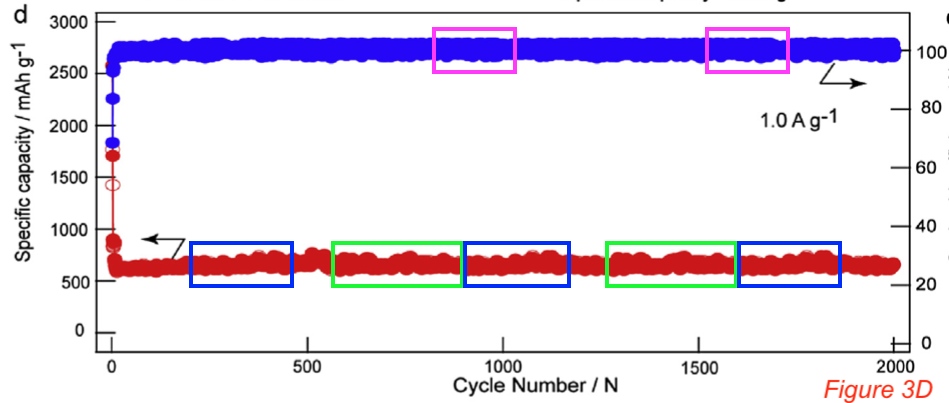
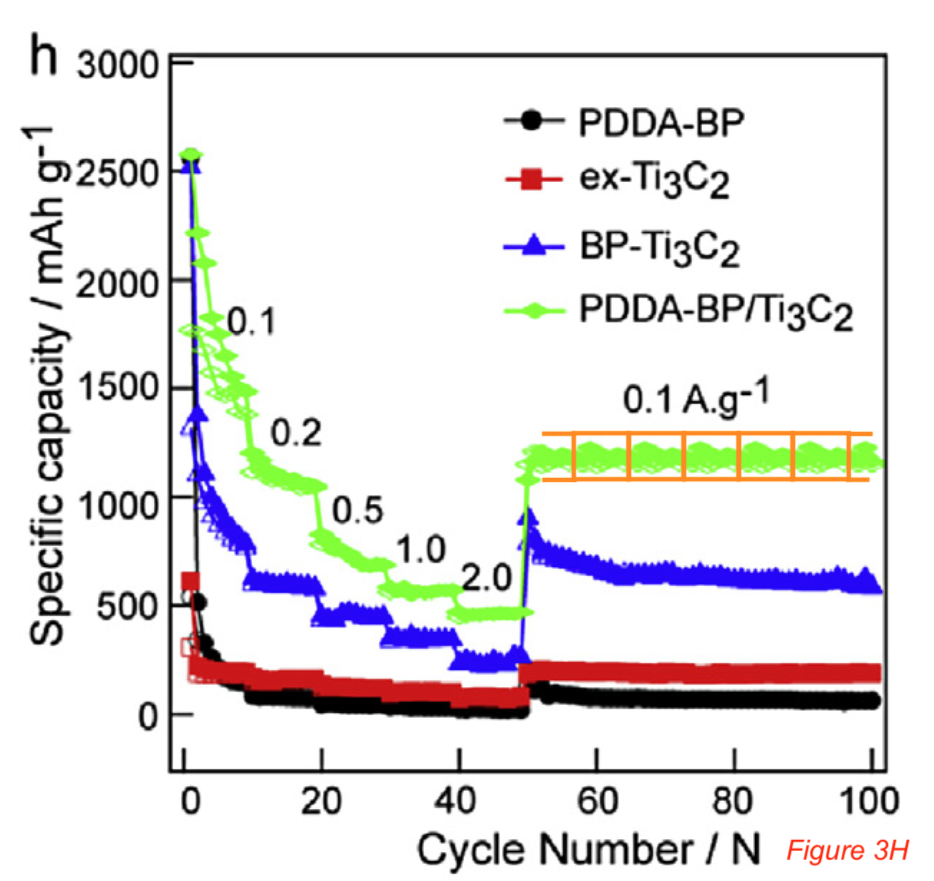
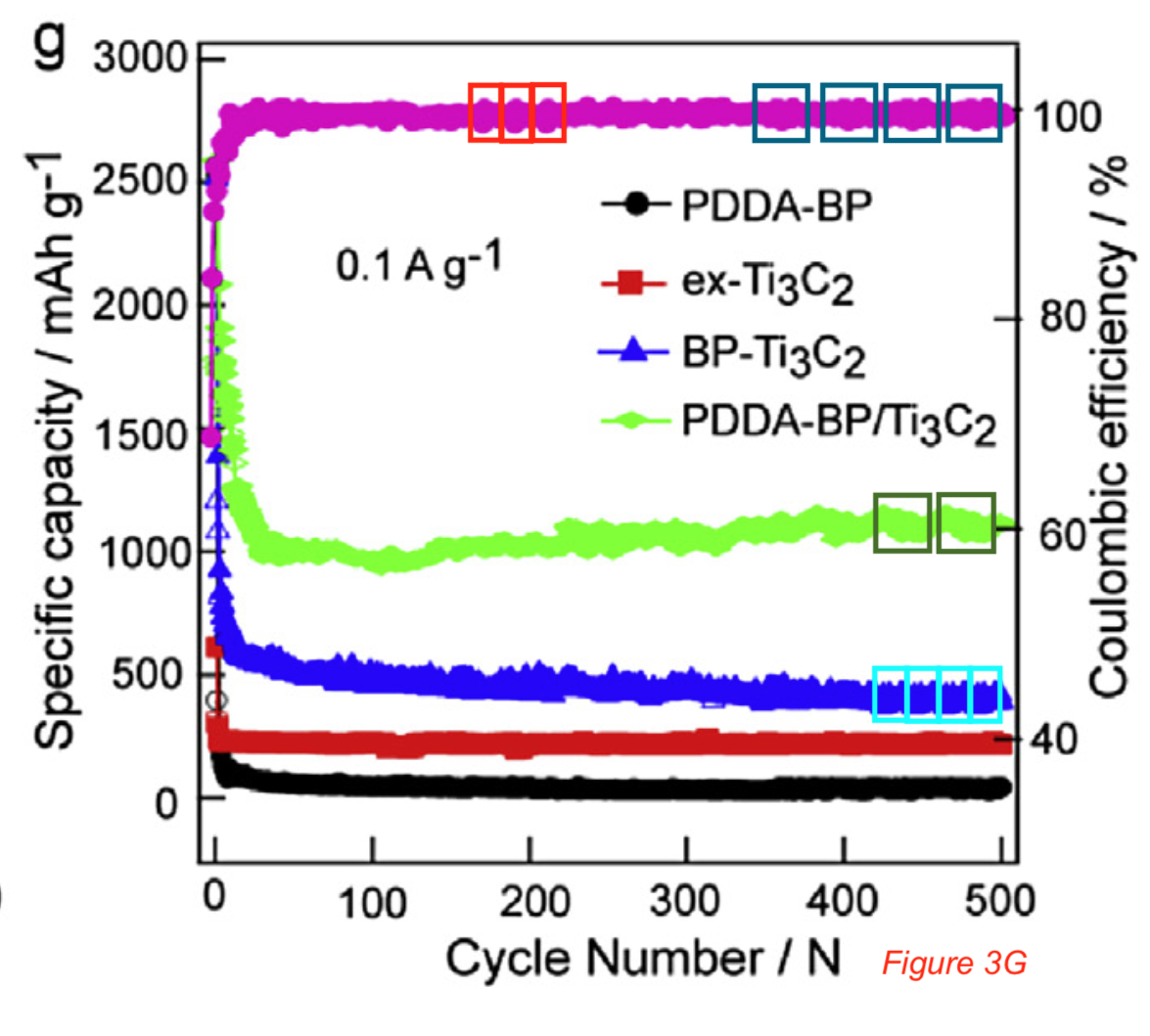
This Yin paper with its ridiculously figures received in June 2021 a Corrigendum:
“In the previously published paper, Fig. 3d, g and h were incorrect. The corrected figures are given below. Kindly note that this correction does not affect conclusions of this paper. The authors apologize for any inconvenience caused to the readers.“
Now, you should know who the Editor-in-Chief of this Elsevier journal Nano Energy is: the Georgia Tech professor Zhong-Lin Wang, fellow of all possible international societies. Unlike Yin, Wang is really a dominant figure in his research field, because he is in USA and because publishes papers faster than a desktop printer can print. In engineering, in order to obtain public and industrial grants only the arithmetical number of your papers is what counts most, most certainly not their content or quality (this is also why the journal impact factors in the field are so ridiculously bloated). The secret of Wang’s publishing productivity seems to be networks, bullshittery and self-plagiarism (see examples here and here, and more on PubPeer). A case of what looks to be outright plagiarism was also flagged.
My regular readers might recall Wang as an associate of the research fraudster and predatory conference scammer Ashutosh Tiwari (read here and here).

Now that you see how low Wang’s own ethics are, you will understand why he corrected Yin’s fraudulent paper. And if you wonder why Elsevier employs such an editor: this publisher specialises on recruiting the most toxic characters to run their journals. Like a pub makes much more money selling booze than tea to alcoholics, so does scholarly publishing generate much more revenue selling bunk, quackery and outright fraud.
Therefore, you can rely on Elsevier simply ignoring this new find:
Xianguang Miao , Xiaoli Ge , Peng Wang , Danyang Zhao , Longwei Yin Size-tunable SnO2/Co2SnO4 nanoparticles loaded 3D reduced graphene oxide aerogel architecture as anodes for high performance lithium ion batteries Electrochimica Acta (2020) doi: 10.1016/j.electacta.2020.136769

Nothing out of order here.
Wiley
This publisher with officially a very dedicated stance of research integrity served us the most bizarre correction for Yin, for fraud uncovered by Bik in a Wiley journal with impact factor of 18.8:
Rui Tang , Shujie Zhou , Caixia Li , Ran Chen , Luyuan Zhang , Zhiwei Zhang , Longwei Yin Janus‐Structured Co‐Ti 3 C 2 MXene Quantum Dots as a Schottky Catalyst for High‐Performance Photoelectrochemical Water Oxidation Advanced Functional Materials (2020) doi: 10.1002/adfm.202000637




You cannot have electron microscopy data faker than this. The Wiley correction, issued, haha, on 1 April 2021, declared:
“In the initially published version of this article, the XPS spectra results in Figure 1D and TEM images demonstrated in Figure 2D–F, Figure S3F, and Figure S10B of the as-synthesized materials were incorrect. […]
The revised images do not influence the data analysis and conclusions of the original paper. They fully support the conclusion.”
A year ago, Wiley took over the Open Access publisher Hindawi, which used to have a relatively decent research integrity record, with fraudulent papers often retracted. But in February 2022, Hindawi’s head of publishing ethics, Matt Hodgkinson (who also previously did great work at PLOS One), abruptly left, his LinkedIn profile lists no new affiliation. Hindawi also stopped replying to emails with evidence of data manipulation.
Maybe Wiley must compete with Elsevier and the new rules do not allow any crackdown on research fraud, so those who have a problem with it must leave? This is just a wild guess here, yet exactly such a thing happened when the US learned society ASBMB outsourced its publishing to Elsevier.
In this regard, here another gift by Wiley for the same team of crooks, in a journal with impact factor of whooping 29.4:
Peng Wang , Caixia Li , Shihua Dong , Xiaoli Ge , Peng Zhang , Xianguang Miao , Rutao Wang , Zhiwei Zhang, Longwei Yin Hierarchical NiCo 2 S 4 @NiO Core–Shell Heterostructures as Catalytic Cathode for Long‐Life Li‐O 2 Batteries Advanced Energy Materials (2019) doi: 10.1002/aenm.201900788
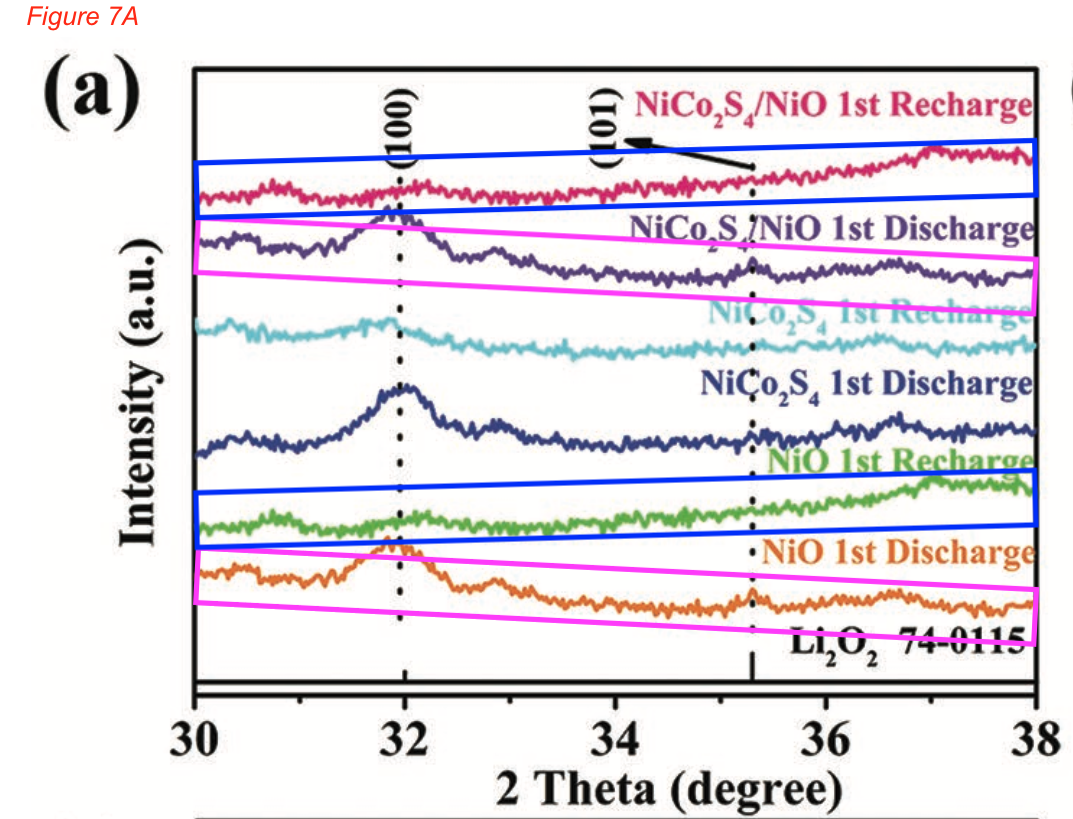
Pink boxes: The purple and orange lines appear to show very similar plots.
Blue boxes: The red and green lines appear to show very similar plots.“

Green boxes: Some parts of the top plot appear to be visible multiple times“
The correction from May 2021 informs:
“In the original published work, Figure 7a, 7c and Figure S11 are incorrect. The correct Figures are presented below […] the relevant paragraph on Page 9 should read as follows:
The diffraction peaks located at about 33.0° and 35.4° can be indexed into (100) and (101) planes of Li2O2 (JCPDS Card No. 74-0115) and no other phases can be observed, unambiguously indicating the generated Li2O2 as the dominant oxygen reduction products for all the three discharged electrodes.[48,49]”
The conclusions of the work are not affected by these errors.”

In another case in same journal, Wiley decided that Bik was an incompetent stalker of scientists and took sides with Yin, not even a correction was issued, apparently Yin convinced the editors that not his paper, but Bik’s evidence was fake.
Xiaobin Hui, Ruizheng Zhao , Peng Zhang , Caixia Li , Chengxiang Wang , Longwei Yin Low‐Temperature Reduction Strategy Synthesized Si/Ti 3 C 2 MXene Composite Anodes for High‐Performance Li‐Ion Batteries Advanced Energy Materials (2019) doi: 10.1002/aenm.201901065


Possible repeats might be observed in the red line too.“
We can glean an insight into that editorial communication because the first author Xiaobin Hui replied on PubPeer:
“Attentively comparing the date, we concluded that although the curves marked with same color boxes in the figures are similar in appearance, but completely different in data and details in enlarged figures.“
No raw data or files was shared, just new drawings and screenshots of spreadsheets. That was enough for Wiley.
American Chemical Society
Enough of greedy commercial publishers who only serve their investors’ interests! Learned societies will surely do better! These fake spectra were published in a journal by the American Chemical Society (ACS), with an impact factor of 15.9:
Ruizheng Zhao, Haoxiang Di, Chengxiang Wang, Xiaobin Hui, Danyang Zhao, Rutao Wang, Luyuan Zhang, Longwei Yin Encapsulating Ultrafine Sb Nanoparticles in Na+ Pre-Intercalated 3D Porous Ti3C2Tx MXene Nanostructures for Enhanced Potassium Storage Performance ACS Nano (2020) doi: 10.1021/acsnano.0c06360
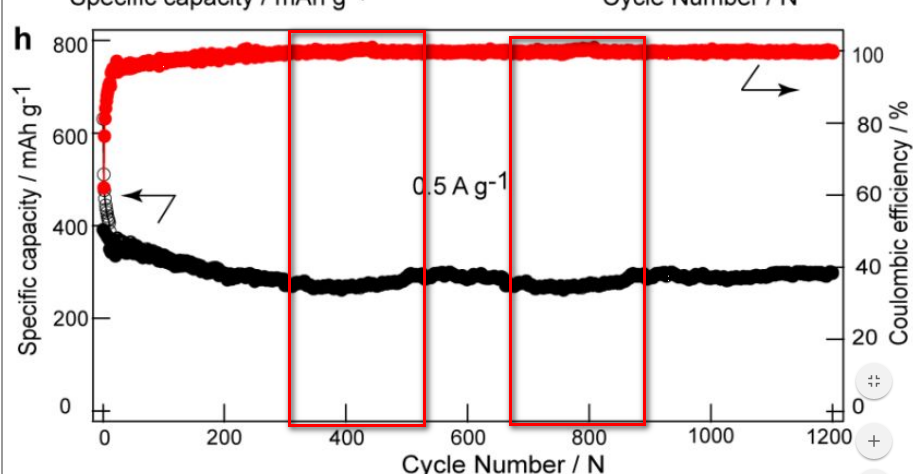

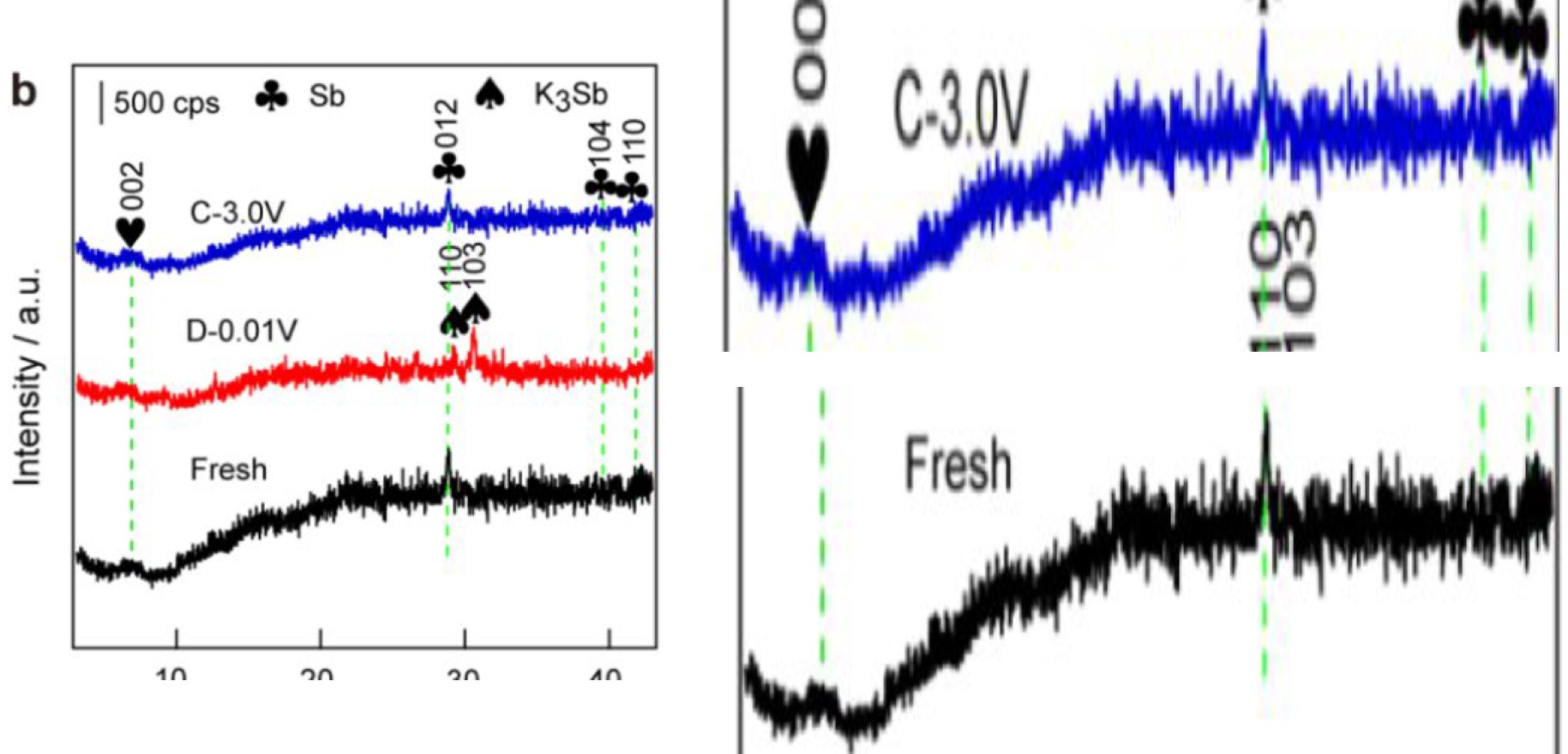
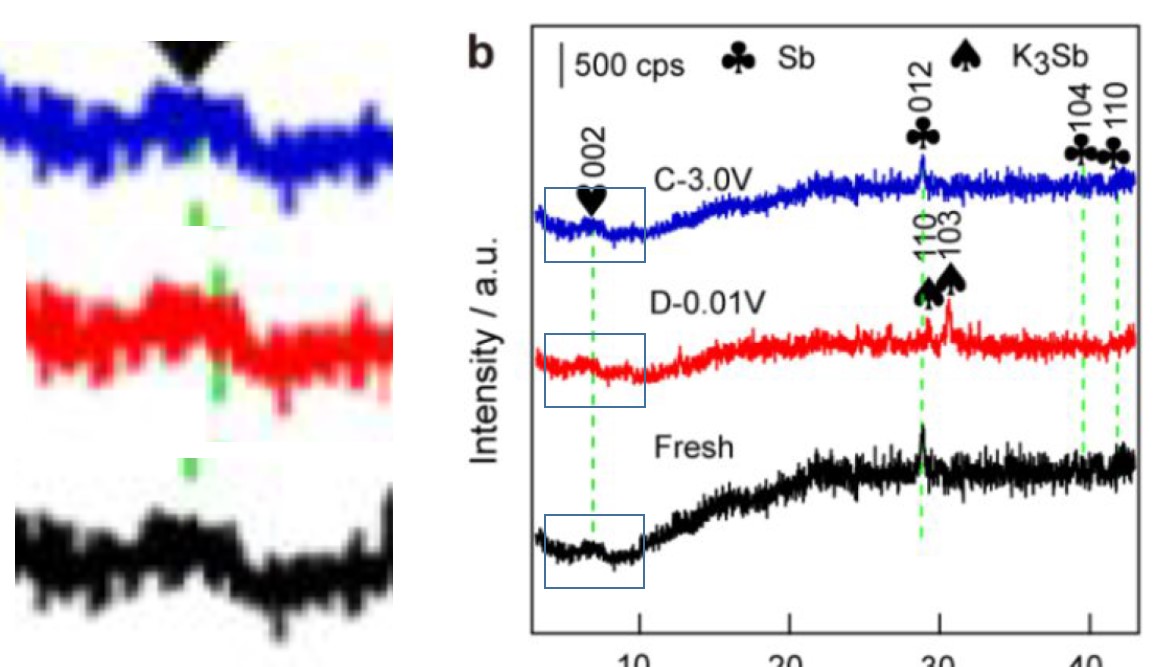
The Corrigendum from March 2021 stated:
“In the previously published paper, ex situ X-ray diffraction patterns in Figure 6b were incorrect. The correct figure is shown above. The correction does not affect the conclusions of this paper. The authors apologize for any inconvenience caused to the readers.“
As you see, ACS did not correct Figure 4, because… because… because it is none of your business. It’s not the first time ACS issues outrageous corrections to fraudulent nanofabricators. Who also happen to be scientific nobodies from China and India, but maybe this is the whole point. They just don’t care, why chasing after honest but boring science, when shiny and exciting fraud is being delivered at your doorstep in a never-ending stream of manuscript submissions. I am sure they actually reject honest research exactly because it does not comply with the bullshit template the publishers learned to expect from fraud.
Royal Society of Chemistry
But maybe another learned society, the Royal Society of Chemistry (RSC) will do something about Yin’s forgeries? The impact factor of this journal is immense: 38.5, so much reputation to defend.
Ruizheng Zhao , Haoxiang Di , Xiaobin Hui , Danyang Zhao , Rutao Wang , Chengxiang Wang , Longwei Yin Self-assembled Ti3C2 MXene and N-rich porous carbon hybrids as superior anodes for high-performance potassium-ion batteries Energy & Environmental Science (2020) doi: 10.1039/c9ee03250a


Four pairs of XRD patterns total.“
Here the Correction from 3 August 2021:
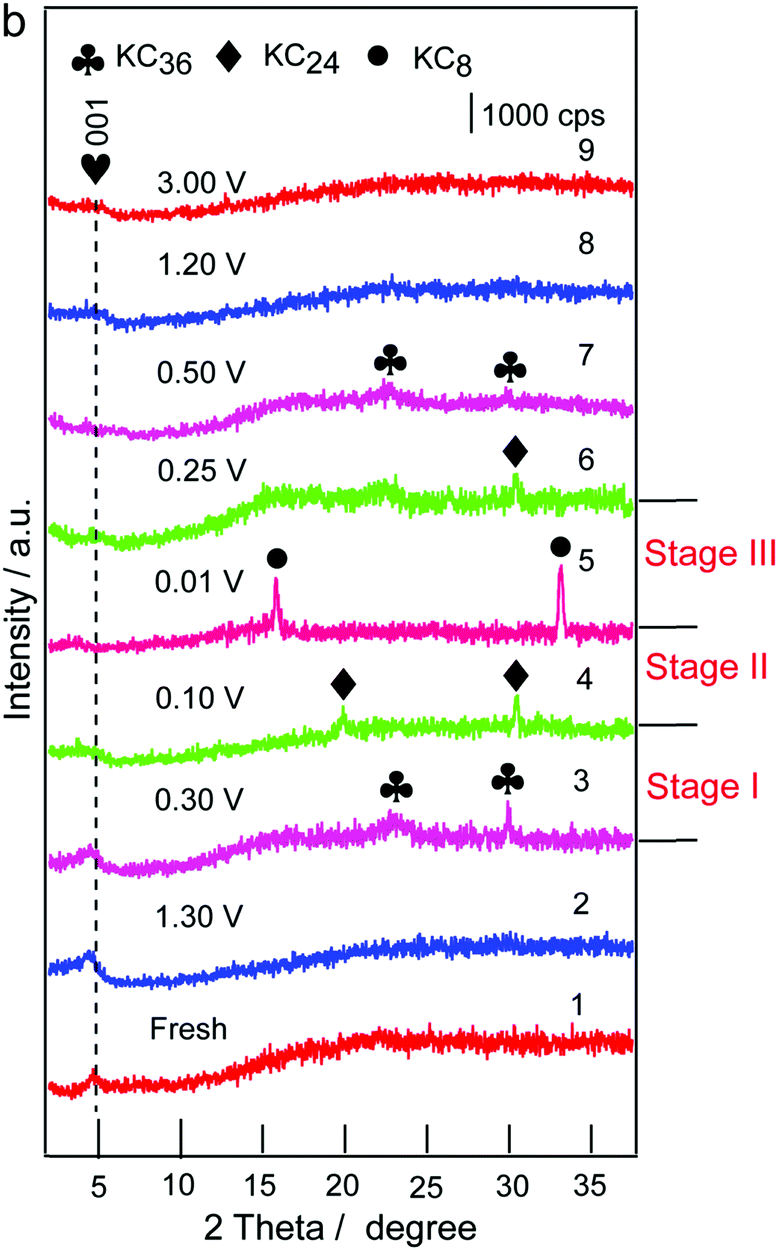
“The authors regret errors in the XRD patterns in Fig. 6b in the original article, specifically patterns 6–9 which were included in error due to unintentionally importing incorrect data. The corrected Fig. 6b is shown below where the top four patterns, 6, 7, 8 and 9, have been replaced with the correct versions. An independent expert assessed the raw data provided by the authors and concluded that it was consistent with the corrected Fig. 6b and with the discussions presented in the article.“
Maybe, but only maybe, and only if the editors are not too busy, this paper might need a correction to its correction:

I did wonder if RSC editors either didn’t check Longwei Yin on PubPeer, or preferred not to. But they must have, in fact here RSC editors agreed, that yes, Bik must be an annoying meddling stalker of scientists who fabricates fake evidence, and they must instead trust Dr Yin fully and unconditionally. No correction was necessary:
Danyang Zhao, Ruizheng Zhao , Shihua Dong , Xianguang Miao , Zhiwei Zhang, Chengxiang Wang, Longwei Yin Alkali-induced 3D crinkled porous Ti3C2 MXene architectures coupled with NiCoP bimetallic phosphide nanoparticles as anodes for high-performance sodium-ion batteries Energy & Environmental Science (2019) doi: 10.1039/c9ee00308h

The first author Danyang Zhao posted on PubPeer a lengthy reply which was very similar in style to that of Xiaobin Hui above, therefore also obviously originally written by Yin as reply to the editors:
“After careful comparison, we can say the profiles in the same color box are similar in appearance, but different in data and enlarged figures. In fact, when they are zoomed in, you can see their differences.“
I trust that after this the editors not only profusely apologised to Yin, but blacklisted Bik from ever submitting complaints again. Imagine, even Wang’s Nano Energy at Elsevier issued a correction (to cover up for obvious fraud), but RSC is apparently that clueless and incompetent that they did nothing at all. No wonder their journals fall prey to Chinese papermills.
Here is another corrected RSC paper by Yin, in a journal with the impact factor of 12.7:
Bo Li , Enyan Guo , Chengxiang Wang , Longwei Yin Novel Au inlaid Zn2SnO4/SnO2 hollow rounded cubes for dye-sensitized solar cells with enhanced photoelectric conversion performance Journal of Materials Chemistry A (2016) doi: 10.1039/c5ta06889d

The Correction from 3 August 2021 declared:
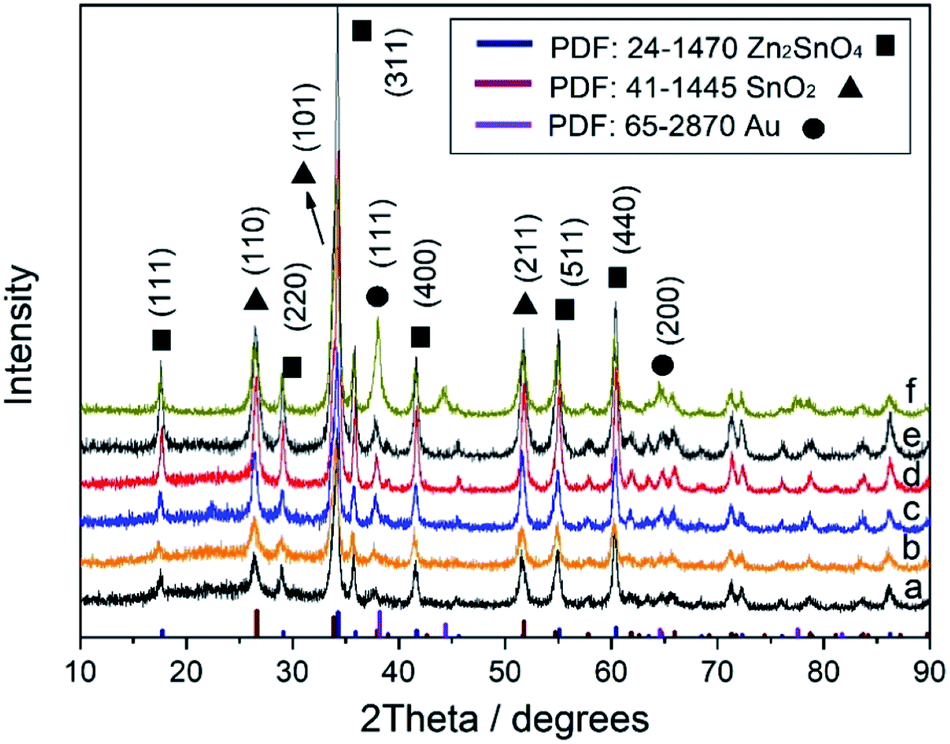
“The authors regret errors in the XRD patterns in Fig. 1 in the original article, specifically patterns (e) and (f), which were included in error due to sample mislabelling. The corrected Fig. 1 is shown below, where the top two patterns, (e) and (f), have been replaced with the correct versions. An independent expert assessed the raw data provided by the authors and concluded that it was consistent with the corrected Fig. 1 and with the discussions presented in the article.“
Apparently, RSC decided against a correction for this paper in the same journal, flagged on PubPeer in January 2021. Presumably Yin educated the editors this is how science is supposed to work, and they concurred.
Bo Li , Yanan Zhang , Lin Fu , Luyuan Zhang , Zhongyuan Liu , Longwei Yin Two-dimensional black phosphorous induced exciton dissociation efficiency enhancement for high-performance all-inorganic CsPbI3 perovskite photovoltaics Journal of Materials Chemistry A (2019) doi: 10.1039/c9ta06016b

Now the editors of RSC will probably reject all submissions where the spectra do NOT look duplicated, suspecting a lack of reproducibility, or even fraud!
Springer Nature
That commercial publisher is of course also affected by Yin’s shenanigans. A Nature Communications paper from Yin’s lab has been just flagged on PubPeer.
Peng Wang , Yingying Ren , Rutao Wang , Peng Zhang , Mingjie Ding , Caixia Li , Danyang Zhao , Zhao Qian , Zhiwei Zhang , Luyuan Zhang , Longwei Yin Atomically dispersed cobalt catalyst anchored on nitrogen-doped carbon nanosheets for lithium-oxygen batteries Nature Communications (2020) doi: 10.1038/s41467-020-15416-4
But maybe there will be no correction? After all, Yin knows how to bullshit, we saw it above. Here another example, evidence from January 2021, in the same Springer Nature journal with the impact factor of almost 15:
Bo Li, Yanan Zhang , Lin Fu , Tong Yu , Shujie Zhou , Luyuan Zhang , Longwei Yin Surface passivation engineering strategy to fully-inorganic cubic CsPbI perovskites for high-performance solar cells Nature Communications (2018)
doi: 10.1038/s41467-018-03169-0

The first author Bo Li posted on PubPeer a lengthy reply which was most likely part of Yin’s letter to the journal, in which the Chinese scholar convinced the editors that he is being maliciously slandered by failed scientists and that no correction was required. In brief, the argument was that the spectra merely appear similar due to four rounds of noise smoothing:

Thallarcha lechrioleuca retorted:
“Smoothing two different XRD patterns will never produce that level of similarity for random noise in my opinion.“
But it doesn’t matter. These papers are not meant to be discussed by scientific peers, the journals made it quite clear.
Nobody responsible for anything
It seems, there is no hope for help from the journals’ academic chief editors, who are all universities professors, our beloved scientific elites, greatest authorities of all wisdom. Too often, these gentlemen (and occasional ladies) are not really involved in the publishing process, which is managed in-house by publisher’s employees. The deal is this: these professors lend the publisher their names for advertisement purposes, and in return they get money (all chief editors are remunerated) and another fancy position to add to their CV.
Here a nanotechnology example unrelated to the Yin affair. The papermill sleuth Nick Wise found a bizarre nonsense paper in the journal Applied Nanoscience, which until Wise’s tweet) has been led by the Nobel Prize winner Sir Fraser Stoddart as Editor-in-Chief. The journal is published by Springer Nature, yet “is fully supported by King Abdulaziz City for Science and Technology (KACST) in Riyadh, Saudi Arabia“. Stoddart’s connection to Saudi academia or the Sunni-Islamic world in general is not immediately obvious.

Stoddart retorted to Wise that he had nothing to do with what his journal publishes, even claiming he worked for the Saudis “unpaid”, if you believe this. And wham, the journal suddenly and very quietly made Stoddart a “Former Editor-in-Chief”.
But then again, even the Nobelist Stoddart is no stranger to questionable science and to questionable corrections thereof.
Well, the take-home lesson is that it is rather pointless to expect publishers and their journal editors to deal with research fraud. But even trying to engage universities and other research institutions is often futile and frustrating. Here another case of nanotechnology and materials science, that of the one-man papermill, Ahmed Shalan.
Shalan is presently being investigated by his current employer in Spain. Yet several of his fabrications happened during his PhD period in Japan, at the University of Hokkaido, supervised by professor Hiroaki Misawa.
A reader tried to get this affair investigated on the Japanese side as well, and tried to reach out to the University of Hokkaido after Misawa ignored all emails. The reader had to recruit the help of a Japanese speaker to find the right email contact. Turned out, he had to send a report to the Sakamoto/Matsuda Law Office (Hokkaido’s Consultation Counter for Accusations), yet also this email went unanswered. After a reminder, the law office replied to my reader on behalf of the university:
“I have not notified the whistleblower that the university will not accept it because it does not meet the requirements.“
My reader did not give up. He submitted a more formal report using the university’s Japanese language template. You probably would like to know how the Hokkaido University reacted?
“Misconduct in research is a matter of concern to Hokkaido
University and we take seriously all allegations of misconduct.
In reply to your request to investigate a doctoral thesis by
Mr. Shalan and your indications on his three other scientific
papers, we would like to inform you that we have learned that
he and his co-authors are aware of the issues posted on the
PubPeer website, and that they are currently in discussions.
We therefore will not be investigating his papers for the
time being.
Provided that he and/or his former mentor recognize possible
wrongdoing(s) in his dissertation, an investigation will be
initiated. If it is found that Mr. Shalan have obtained his
degree by fraud, the university will determine whether the
degree previously granted to him should be revoked.
Please note that we will not keep you updated in this matter
for the aforementioned reasons.
Thank you for taking the time to let us know your assertions
and kind regards,
Hokkaido University”
In brief, Hokkaido University decreed that is solely up to Shalan and Misawa to decide if their papers and PhD thesis should be investigated, or not.
Contact Form
I thank all my donors for supporting my journalism. You can be one of them!
Make a one-time donation:
I thank all my donors for supporting my journalism. You can be one of them!
Make a monthly donation:
Choose an amount
Or enter a custom amount
Your contribution is appreciated.
Your contribution is appreciated.
DonateDonate monthly

One frequent first author of Yin’s questioned/”corrected” papers, Ruizheng Zhao, was a PhD student of Yin. She was a highly praised model student who would be confident enough to brag about her success story in front of her fellow students in an organized event seen here http://www.cmse.sdu.edu.cn/info/1052/14523.htm
Here is a corrected Google translated paragraph regarding Zhao’s teaching:
“At the beginning of the meeting, Zhao Ruizheng first shared her doctoral academic experience and thesis writing experience. In the report, she gave a detailed introduction from the aspects of personal introduction, doctoral academic experience, thesis writing and manuscript submission, and career planning for after graduation, etc. She also shared with the audience a brief introduction to her representative academic achievement – molecular-level heterojunction. When talking about scientific research, Zhao told her audience that they must remain rigorous at work and keep keen observation.”
I wonder, with 6 of her papers on Pubpeer, how rigorous an attitude Zhao has assumed in her own work.
LikeLike
I think it should be a matter of policy at any real journal that authors who want to get a paper corrected for image problems need to provide some credible explanation as to how the mistake happened. I can understand for instance accidentally plotting the same column of your data set twice, or even putting a wrong label on a photo. These things can happen by accident. But how do such manipulated TEM pictures even come to be? Just saying “the image was wrong” should not be considered an acceptable explanation. Of course, for predatory journals such as those discussed here, it doesn’t really matter because clearly nobody cares.
LikeLike
See https://riviste.unimi.it/index.php/roars/article/view/9073 for an article about Moylan. No one has until now informed me that this article contains errors or mistakes. Moylan does not communicate with me.
LikeLike
“Imagine what these publishers and their academic editors would do for someone more important.”
Sack any (junior) staff who’d even try to say the word “investigation”?
LikeLike